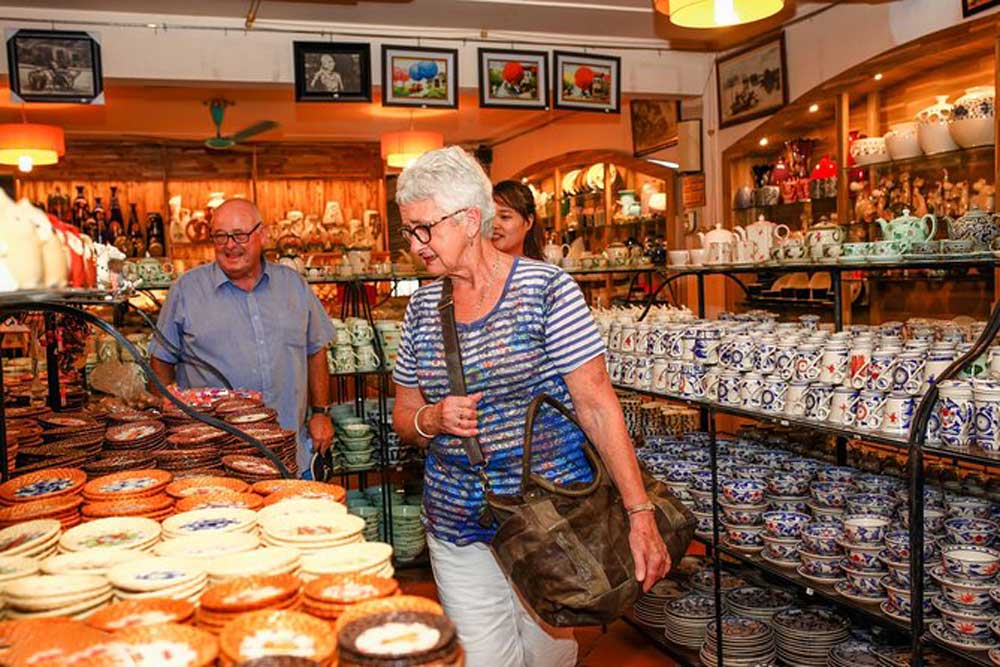News
Analyze the Economic Impact of Bat Trang Ceramics
Bat Trang ceramics, a centuries-old craft originating from the village of Bat Trang in Vietnam, represent one of the most iconic and culturally rich pottery traditions in Southeast Asia. Known for their exquisite craftsmanship, unique glaze techniques, and artistic designs, Bat Trang ceramics have transcended local markets to influence global ceramic art and commerce. The economic impact of Bat Trang ceramics is multifaceted, encompassing local employment, cultural tourism, international trade, and the preservation of artisanal heritage. This article deeply analyzes the broad economic ramifications of Bat Trang ceramics, shedding light on its contribution to regional development, market dynamics, and cultural sustainability.
Historical and Cultural Significance as an Economic Driver

Understanding the historical and cultural roots of Bat Trang ceramics provides essential context to appreciate its current economic relevance. The long-standing tradition not only attracts tourists but also establishes a strong brand identity that fuels commercial success.
Before diving into the various economic layers, it is important to recognize how the rich culture surrounding Bat Trang ceramics fosters demand and value in both domestic and international markets.
The Origins and Evolution of Bat Trang Ceramics
Tracing back over 700 years, Bat Trang ceramics originated during the Ly dynasty period and have continuously evolved in style, technique, and production scale. This deep-rooted history contributes to the intrinsic value attributed to Bat Trang products today.
The evolution of Bat Trang ceramics features a blend of functional wares and artistic forms, influenced by changing societal needs and technological advancements. Its resilience through historical upheavals has made the craft a symbol of Vietnamese heritage.
Moreover, the longevity of this craft means generations of artisans have perfected techniques that cannot be easily replicated elsewhere, giving Bat Trang ceramics a competitive edge in quality and authenticity.
Cultural Identity and Brand Recognition
Bat Trang ceramics serve as cultural ambassadors for Vietnam, representing more than just utilitarian objects—they embody national pride and artistry. This identity enhances their market appeal both domestically and abroad.
The village itself has become synonymous with high-quality ceramics, making “Bat Trang ceramic” a recognizable and trusted brand name. This branding strengthens consumer confidence and willingness to pay premium prices.
Cultural festivals and exhibitions centered on Bat Trang crafts further reinforce this recognition, drawing visitors who contribute significantly to the local economy through tourism-related spending.
Heritage Preservation and Economic Sustainability
Preserving traditional ceramic-making methods is crucial not only for cultural reasons but also for sustaining economic viability in a globalized market where mass-produced goods dominate.
Efforts to maintain authentic practices ensure Bat Trang remains distinctive. This uniqueness allows artisans to command higher prices and attract niche markets looking for genuine handmade products.
As younger generations are trained in these arts, the community sustains a skilled labor force, preventing economic decline often associated with rural industrial shifts.
Local Economic Development and Employment Opportunities

Bat Trang ceramics play a vital role in driving local economic growth, supporting thousands of households through direct and indirect employment. The industry’s influence extends beyond manufacturing to include retail, education, and service sectors linked to ceramic production.
This section explores how Bat Trang ceramics create jobs, improve livelihoods, and foster community development.
Artisan Employment and Skill Development
The ceramics industry in Bat Trang is labor-intensive, requiring specialized skills in shaping, glazing, firing, and decorating. These roles provide steady income opportunities for many villagers.
Artisans range from master potters to apprentices, creating a hierarchical skill structure that encourages knowledge transfer. Training programs and workshops help develop new talent, ensuring the craft’s continuity.
Beyond technical skills, artisans often gain entrepreneurial and marketing abilities, empowering them to manage small businesses or cooperatives effectively.
Ancillary Industries and Supply Chain Linkages
Bat Trang’s ceramic production supports a variety of ancillary industries such as raw material suppliers (clay, glaze components), equipment manufacturers (kilns, tools), and transportation services.
These interconnected sectors generate multiplier effects within the local economy, amplifying income beyond just ceramic producers. For instance, quarry workers extracting clay benefit directly from Bat Trang’s demand for quality raw materials.
Logistics firms that assist in distributing ceramics to urban and international markets also expand economic activity, illustrating the broad reach of this craft-based economy.
Tourism and Hospitality Services
Bat Trang Village has leveraged its status as a ceramic hub to attract tourists interested in cultural experiences, studio visits, and hands-on pottery classes.
Tourism boosts revenues for local restaurants, hotels, souvenir shops, and guides, creating additional employment and business opportunities unrelated to ceramic manufacturing per se.
The integration of cultural tourism with ceramics enhances the community’s economic resilience, particularly during periods when export demand fluctuates.
Market Dynamics and International Trade

A significant dimension of Bat Trang ceramics’ economic impact lies in their role within global markets. With rising international demand for artisanal goods, Bat Trang ceramics have positioned themselves competitively in diverse markets.
This segment discusses market trends, export activities, pricing strategies, and challenges faced by the Bat Trang ceramics industry.
Export Markets and Global Reach
Bat Trang ceramics are exported to numerous countries, including the United States, Japan, South Korea, and European nations. Their appeal lies in blending traditional aesthetics with functional design suitable for modern consumers.
Export growth is driven by increased awareness of cultural products, e-commerce platforms, and participation in international trade fairs.
However, maintaining consistent quality and meeting foreign regulations remain ongoing challenges for many producers.
Pricing Strategies and Product Differentiation
Artisans adopt varied pricing models depending on product complexity, size, and target buyer segments. High-end decorative pieces command premium prices due to their artistry, while everyday tableware targets mass markets.
Differentiating products through innovation in design and glazing techniques helps Bat Trang ceramics stay competitive against cheaper imitations and industrially produced alternatives.
Creating limited edition collections or collaborations with designers can further add value and justify higher price points.
Challenges in Competition and Market Access
Despite strengths, Bat Trang faces competition from other ceramics hubs globally, especially those offering lower production costs.
Additionally, access to international markets involves navigating tariffs, shipping logistics, and marketing investments which small-scale artisans may find difficult.
Combating counterfeit products that mimic Bat Trang designs but lack authenticity is another significant issue threatening brand integrity.
Innovation and Technological Adaptation in Production

While rooted in tradition, Bat Trang ceramics industry has embraced selective innovations to improve efficiency, quality, and environmental sustainability.
This part examines how the integration of technology affects productivity and economic outcomes without compromising artisanal values.
Modern Kiln Technologies and Efficiency Gains
Traditional wood-fired kilns, though culturally significant, have been supplemented by electric and gas kilns that offer better temperature control and reduced emissions.
Adopting these technologies improves product consistency and shortens production cycles, increasing output capacity and reducing costs.
This shift aligns with global trends favoring environmentally friendly manufacturing, enhancing Bat Trang’s appeal in eco-conscious markets.
Digital Design and Marketing Tools
Some Bat Trang artisans use computer-aided design (CAD) software to experiment with patterns and prototypes before physical production.
Digital marketing platforms like social media and online marketplaces enable wider customer engagement, facilitating direct sales and feedback collection.
These tools democratize access to global consumers, helping small producers compete beyond local confines.
Environmental Sustainability Initiatives
Increasing awareness of ecological impacts has led to initiatives promoting sustainable raw material sourcing, recycling waste clay, and reducing harmful chemical glazes.
Such efforts not only protect natural resources but also create marketing advantages among environmentally aware buyers.
Sustainability certifications and transparent production practices build trust and open doors to premium market segments committed to ethical consumption.
Socioeconomic Benefits and Community Empowerment
The economic impact of Bat Trang ceramics extends beyond monetary gains to include improved social welfare and community cohesion.
Exploring these non-monetary benefits reveals deeper insights into how traditional crafts contribute to holistic rural development.
Women’s Empowerment and Gender Roles
The ceramics industry in Bat Trang actively involves women in various production stages, providing them with independent income and decision-making power within households.
Participation in cooperative groups and training programs enhances women’s skills and social networks, fostering gender equality.
Economic empowerment often correlates with improved family health, education, and community stability.
Education and Youth Engagement
Teaching pottery skills to youth helps preserve cultural heritage and offers career pathways in creative industries.
Ceramic schools and apprenticeship systems motivate young people to remain in their communities rather than migrating to urban areas in search of work.
Engaging youth in local industries promotes innovation blended with tradition, securing future economic sustainability.
Social Capital and Cultural Pride
The collective identity centered on Bat Trang ceramics strengthens social bonds and mutual support mechanisms among residents.
Festivals, exhibitions, and communal workshops encourage cooperation, enabling shared problem-solving and resource pooling.
This social capital translates into resilient communities capable of adapting to economic or environmental shocks.
Data Presentation: Economic Contributions of Bat Trang Ceramics
| Economic Aspect | Contribution Details |
|---|---|
| Employment | Over 10,000 direct artisan jobs; thousands indirectly supported |
| Export Revenue | Estimated $15 million annually from international sales |
| Tourism Impact | Approximately 50,000 visitors yearly boosting local services |
| Ancillary Industry Support | Clay extraction, kiln manufacturing, transport logistics |
| Gender Participation | Women constitute ~60% of ceramic workforce |
| Innovation Adoption | 30% of producers use modern kilns; 25% employ digital tools |
Conclusion
The economic impact of Bat Trang ceramics is profound and multifaceted, spanning local employment generation, international trade, cultural tourism, and community empowerment. Rooted in a rich historical tradition, Bat Trang ceramics leverage cultural identity to achieve global recognition and market success. The industry not only preserves artisanal skills passed down through centuries but also adapts to contemporary challenges via technological innovation and sustainable practices. By contributing significantly to household incomes, supporting ancillary sectors, and stimulating tourism, Bat Trang ceramics drive regional economic development while fostering social cohesion and gender empowerment. As global appreciation for handcrafted and culturally authentic products grows, the Bat Trang ceramics industry stands poised to sustain and enhance its vital economic role for generations to come.
